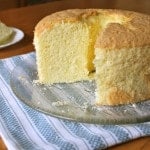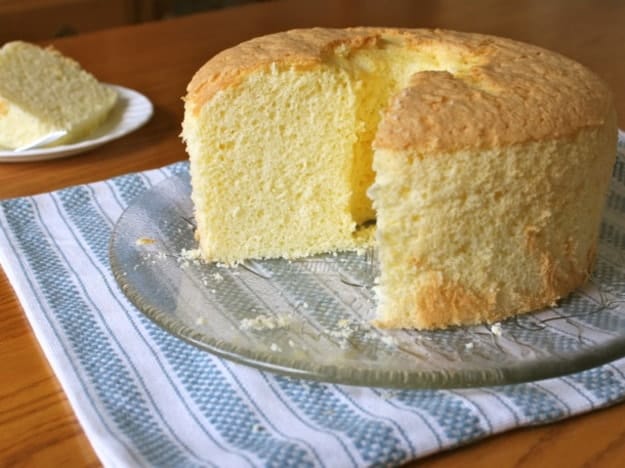This gluten-free chiffon cake is a showstopper. Light and airy, it’s angel food cake’s richer cousin.
For a cake with such whisper-soft texture, chiffon cake certainly made some noise when it entered the food scene. The recipe was created–and kept top secret for around two decades–by a salesman-turned-caterer named Harry Baker. Before Baker sold the recipe to General MIlls in 1948, he made chiffon cakes for the Hollywood Brown Derby and the light cake quickly gained a following.
Capitalizing on its popularity, General Mills released the recipe along with the claim that it was, “The first new cake recipe in 100 years.” (Sounds like something Don Draper would write, doesn’t it?)
Leavened mostly with whipped egg whites, chiffon cake bakes up light and airy, similar in texture to angel food cake. Unlike angel food cake, which only uses egg whites, chiffon cake uses the entire egg. The yolks are mixed into the batter before being folded into the whipped egg whites. They bring richness and a subtle yellow hue to the cake.
The original recipe for this cake relied on pastry flour; this low gluten flour gave the cake a soft, tender crumb. So converting it to gluten-free was relatively easy because the cake never fully relied on gluten structure to give it structure. White rice flour, potato starch and tapioca starch replaced the pastry flour nicely; heavier flours, like brown rice flour and sorghum proved too heavy for the cake, leaving it with a dense crumb and unpleasant, gritty texture. Made with white rice flour, it baked into the lightest, softest cake I’ve ever had (!). In this case, the lack of gluten seems to have benefited the cake.
To achieve that light, soft texture, it takes a bit of care to put the cake together. No one would call this a quick recipe! Keep these tips in mind when putting the cake together.
How to Make Gluten-Free Chiffon Cake
Degrease your mixing bowl and whip. Egg whites and fat are enemies. If any fat is present, the egg whites won’t whip to full volume. Before you crack your first egg, check your mixing bowl and whip. If any grease is present, get rid of it by washing the bowl with soap and water. (Some bakers swear by using lemon juice or white vinegar to wash the bowl.)
Start with cold eggs. While egg whites are best whipped at room temperature, they’re harder to separate when warm. To get around this, separate the eggs when they’re cold and then allow them to come to room temperature before whipping.
Keep egg yolks out the egg whites. Be sure no egg yolk finds its way into the bowl of whites. It’s a good idea to separate your egg over two bowls, a small one for the whites, and a large one for the yolks. After separating the egg, inspect the white. If no yolk is present, transfer the white to a large grease-free mixing bowl. This way, you’re sure that each egg white that goes into the bowl is yolk free.
Use a large bowl for the batter. You’ll be folding the whipped egg whites into the cake batter. Therefore, it’s essential to select a bowl that can hold a lot of batter. I used my 5 quart bowl for the recipe.
Add the whipped egg whites in stages. For the first addition, you want to lighten the batter by gently folding in about a quarter of the whipped egg whites. After that, fold in each addition of egg white until no lumps remain. (More about lumps in a second.)
Keep the spatula under the batter. Here’s a little egg white folding trick: As you fold the egg whites into the batter, keep your spatula submerged in the batter at all times. Don’t lift it out of the batter after each “fold” Rather, slide the spatula into the center of the bowl, then “fold” the batter by pulling the spatula toward the edge of bowl, lifting batter over the egg whites. Then bring the spatula back toward the center of the bowl to incorporate the whites into the batter. As you fold, it helps to slowly spin the bowl.
Check for lumps in the batter. Before you stop folding the egg whites into the batter, check for unincorporated egg whites. None should remain. If they do, the finished cake will bake unevenly with large air holes throughout. If you see any lumps of egg whites, fold a little longer. Don’t “whack” the spatula on the side of the bowl. It’s tempting to clear the egg whites that cling to the spatula by whacking the spatula on the side of the bowl. This deflates the batter. Same thing goes for when you add the batter to the pan. Don’t whack the spatula on the side of the cake pan to get rid of excess batter.
Don’t grease the pan. During baking, the batter clings to the side of the ungreased pan, helping the cake stay nice and high. This is one time where a cake sticking to a pan is a good thing!
Cool the cake upside down. Even after baking, chiffon cakes require a little extra TLC. To prevent the cake from collapsing, cool it upside down. Today, many tube pans include little legs that you can invert the pan onto. However, if your pan doesn’t have legs or if your cake rises higher than the legs, carefully slide the center of the cake pan onto a glass bottle–like a wine bottle or gluten-free beer bottle.
And while this cake requires almost-scientific precision, it still welcomes creativity. As written, the recipe makes a vanilla-scented chiffon cake. But flavor it as you wish–orange and lemon are always popular variations.
*Low-gluten pastry flour contains gluten and is not suitable for those on a gluten-free diet.

Gluten-Free Chiffon Cake
Light and airy gluten-free chiffon cake.
Ingredients
- 1 1/2 cups granulated sugar (10 1/4 ounces; 290 grams_
- 1 1/4 cups finely ground white rice flour (5 ounces; 142 grams)
- 1/2 cup potato starch (2 ounces; 56 grams)
- 1/4 cup tapioca starch (1 ounce; 28 grams)
- 1 tablespoon baking powder
- 1 teaspoon salt
- 1/2 teaspoon xanthan gum
- 7 large eggs, separated (For the whites, about 8 3/4 ounces; 248 grams. For the yolks: 3 1/2 ounces; 100 grams)
- 3/4 cup water (6 ounces; 170 grams)
- 1/2 cup vegetable oil (3 1/2 ounces; 100 grams)
- 2 teaspoons vanilla extract
- 1/4 teaspoon cream of tartar
Instructions
-
Adjust oven rack to middle position and preheat oven to 325°F. Whisk together granulated sugar, white rice flour, potato starch, tapioca starch, baking powder, salt, and xanthan gum in medium bowl. Set aside. In large mixing bowl, whisk together egg yolks, water, vegetable oil, and vanilla extract. Add whisked dry ingredients. Mix until thick batter is thick and smooth.
-
In bowl of stand mixer fitted with whisk attachment, combine egg whites and cream of tartar. Whip on high speed until medium peaks form. Add whipped egg whites, one quarter at a time, to batter. Fold, taking care not to deflate the batter, until no large lumps of egg whites remain.
-
Spoon batter into ungreased 10-inch tube (angel food) pan. Bake until cake is golden brown and springs back to the touch, about one hour. Remove from oven and immediately invert pan either onto legs that are on the pan or onto the neck of a beer or wine bottle. Allow cake to cool in the pan upside down.
-
To remove cake from pan, run a knife around the outside of the cake and around the tube. Turn cake onto a serving plate. Store cake, covered, on the counter for up to four days.




Elizabeth says
This looks wonderful! I was recently diagnosed with celiac, and I’ve had to (hopefully temporarily!) stop dairy too. I do not actually have a tube pan – would a bundt pan work just as well, or is there something special about the tube pan? Thank you!
Elizabeth says
Hi Elizabeth!
This is a great question. I know that angel food cakes can’t be made in a bundt pan because they require a pan that has no coating. To be honest, I’m not sure about baking a chiffon cake in a bundt pan! Two things I’d worry about: the size of the pan. Tube pans tend to be larger. 2. The shape of the bundt. Since this is really an eggy batter, it might stick in all those nooks and crannies.
I’m so sorry that I don’t have a better answer!
Amber says
I grew up making chiffon cakes. No to a Bundt pan. But we did make it in a 9×13 if you have one of those.
Viv says
Hello!
Would the recipe work without the 1/2 teaspoon xanthan gum?
Thank you.
Elizabeth says
No, the xanthan gum gives the cake structure. Without it, the cake would collapse.
Andrea says
Hello
This recipe sounds great. I live in France and we don’t have cream of tartar here. Can I replace it by something else ?
Thank you
Elizabeth says
Ah, yes. This is an issue for folks living in France. For this recipe, I think you could skip the cream of tartar and the cake would work.
Jamie says
You can replace cream of tarter with white vinegar or lemon juice. I’ve got my first batch of gf chiffon in the oven now. So looking forward to the outcome! Good luck!
Ana says
Can you bake this cake in a regular 8″ pan?
Elizabeth says
I haven’t tested it in a round cake pan. So I can’t say.
Anita Wallace says
I baked this cake for 60 minutes on convection bake (air circulation plus heating element below cake) in an ungreased aluminum 10-inch tube pan. At 60 minutes, the cake was golden brown and sprang back to the touch, and a toothpick came out clean. When I removed the pan from the oven and inverted it onto a bottle, the cake came tumbling out, in pieces, onto the counter. The pieces, of course, “deflated” rapidly. There was crust stuck to the pan, suggesting that an overly slick pan was not the problem. My only departures from the recipe were the substitution of ¾ cup unsweetened passion fruit juice (Boiron) for the water, and addition of one extra egg white.
I just noticed that on your excellent website glutenfreebaking.com, the half cup of potato starch is listed as weighing 2 ounces, rather than the 3 ounces listed on seriouseats.com. Which is preferable? I used the 3 ounces in my (spectacularly tumbling from the inverted pan) cake. Could that be part of the problem?
Do you have any recommendations? Increase the xanthan gum to ¾ tsp? Add psyllium husk powder? Omit the extra egg white? Bake it longer? Set the oven on either convection or regular bake rather than the combo convection bake setting? Just cool the cake in the pan upright without inverting the pan, and live with the inch or more of height reduction as the cake cools? The cake fragments were delicious, and I’d like to be able to invert the cake as the recipe specifies.
Elizabeth says
I’m fairly certain that replacing the water with passion fruit juice, especially if it was Boiron’s passion fruit puree, would have caused this problem. I’d try the recipe with water and let me know how it goes.
Also, the pan isn’t nonstick is it? That will also cause a problem. I’m guessing not since some of the cake stuck. 🙂
Anita Wallace says
Elizabeth, thanks so much for replying! The pan was an ordinary aluminum 10-inch tube pan, not a nonstick pan. I will try the recipe with water, as you suggest.
Do you have any inkling as to what my next step should be in developing a gluten-free passion fruit chiffon cake? The cake’s flavor was gloriously floral and unmistakably passion fruit — my all-time favorite fruit. So I really hope to be able to make a passion fruit chiffon cake. Based on your extensive experience with gluten-free baking, would you think that any of the approaches I mention above would be helpful? Do you have a theory as to why the passion fruit puree kept the cake from holding together? Would its acidity do that? If so, would adding a bit of baking soda help? Would substituting coconut flour for part of one of the flours add more structure? Would adding psyllium husk powder make the cake more cohesive and add structure? If so, would soaking the psyllium husk powder in the passion fruit juice eliminate the grittiness that sometimes results from psyllium husk powder? And should a half cup of potato starch weigh 2 ounces, rather than the 3 ounces listed on seriouseats.com? I had used 3 ounces by weight. Any other ideas for maneuvers that might conceivably help? I am willing to try untested ideas – perhaps you could help me figure out which change to try first?
Anita Wallace says
Or should I try increasing the xanthan gum?
tlicious says
Hi,
Do you think I can use freeze-dried strawberries in this to make a strawberry chiffon? Or do you think the acids in the strawberries (even if freeze dried) will degrade the starches? (I plan to substitute Arrowroot for the potato starch because it’s my understanding arrowroot does not degrade with acid and can be subbed 1:1 for potato starch.) (I saw the comment re: passion fruit juice and am trying to avoid that problem.)
Thank you.
Elizabeth says
Oooh! This is an excellent question. I think freeze dried strawberries would work! They don’t carry the extra sugar/moisture that passion juice does. If you give it a try, let me know how it works!
Donna says
This cake is beautiful! I used a Nordic Ware tube pan that said non stick, but left it untreated, and the cake stayed put. I substituted a tsp of vinegar for the cream of tartar in the egg whites. I was very impressed with the results; soft, light and delicious. Next time, I’ll probably add a little extra vanilla.
Irene says
Can’t wait to try this recipe. What can I substitute Xanthan gum?
Elizabeth says
I haven’t tried this recipe without xanthan gum, so I can’t say. Sorry!
Anna says
Hello!
Would adding coconut or banana extract to this affect the texture or shape of this cake?
Elizabeth says
Extracts are a fine addition to this cake!
Angie says
This is the go-to birthday cake in our house. I’ve made it countless times. Great recipe!
If I have orange juice on hand I’ll use it for part of the water measure. Also I like using King Arthur’s Fiore di Sicilia extract in the batter for a wonderful orange/vanilla flavor.
Thank you!
Angie says
Looking for a chocolate version. Any ideas?
Elizabeth says
I don’t and I’m not sure if replacing some of the gluten-free flour with cocoa powder would be a good idea for this one. If I think of something, I’ll let you know.
James L Adcock says
I followed this recipe to the T — using gram-measures. I had extra liquid egg whites in the house, which I needed to bring the egg-white measure to the exact gram-count. And I was extremely paranoid when it came to folding in the egg whites. And it paid off spectacularly! Perfect cake! I was amazed. “No one would ever guess it was gluten free” — and I never talk like that! No, really — it was amazing!
Elizabeth says
Yay! I’m glad you liked it!
Suzanne says
I made this gorgeous cake yesterday and the only thing I changed is that I used King Arthur Measure for Measure gf flour, which already has xanthan gum in it. The cake turned out perfectly, with an open, airy, and moist crumb. Cooked up in exactly 60 minutes. Thank you so much for this amazing recipe!!!
Andrea says
Just made this recipe tonight and it’s the first gf cake I’ve made that actually worked perfectly! So delicious!
Paul says
Superb recipe. I used the Good Value Walmart brand of GF flour, formulated with all the ingredients of the recipe, with the xanthan gum already included (resulting in a 2 cup total measure). I also add sugar to the wet ingredients, blending well, so the sugar is well dissolved. Flour, salt and leavening added to create a smooth batter… then fold. Perfect every time. Thanks again.
Carina Livoti says
I’ve been using this recipe to great success for years, but I tried something recently that was just too good not to share. For starters, I typically replace all the flours combined and the xanthan gum with Cup4Cup by weight. I am lazy and also the first time I tried to make this, it was all I had on hand. It turned out so beautifully I didn’t want to roll the dice by switching things up. But this last time, I also swapped the vanilla extract for almond, and Let. Me.Tell. You. It was A++++. Highly recommend both this recipe and an almond experiment.
Peggy says
Amazing! I’ve made the “normal” version of this recipe and wasn’t sure how a GF one would fare. Just made it with Dove Farms Self-Raising GF and 2 tsp baking powder…truly incredible! My only change was adding 1 tsp lemon extract (in addition to the vanilla).
Sarai says
This cake was fabulous! Absolutely delicious. We made it as a traditional layer cake with strawberries and marscapone whipped cream. Perfect.